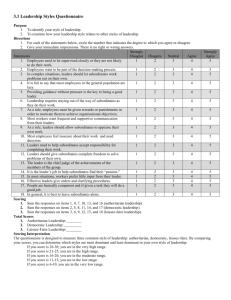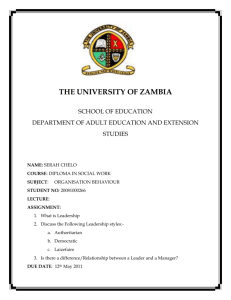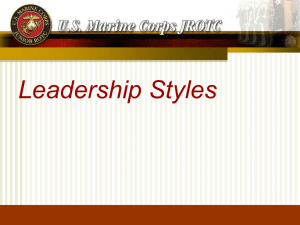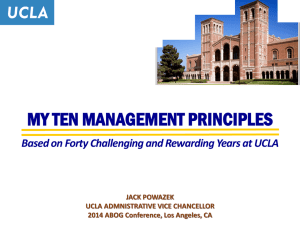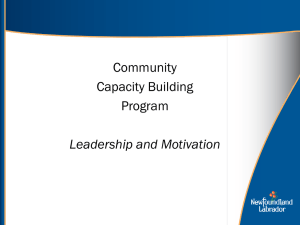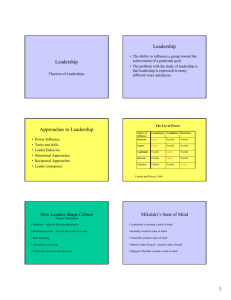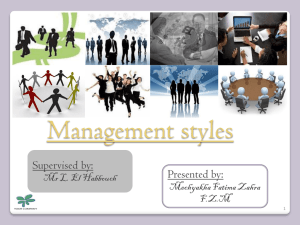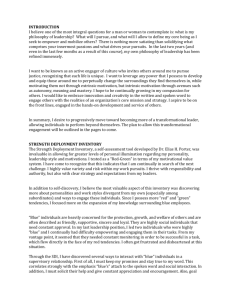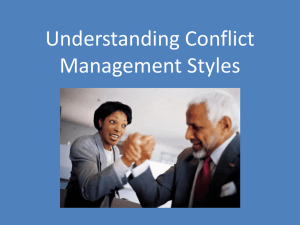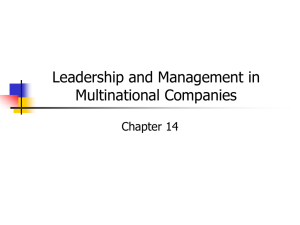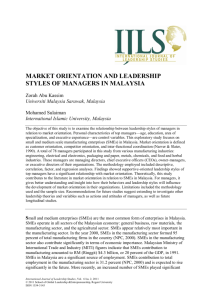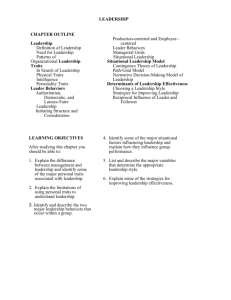Leadership
advertisement
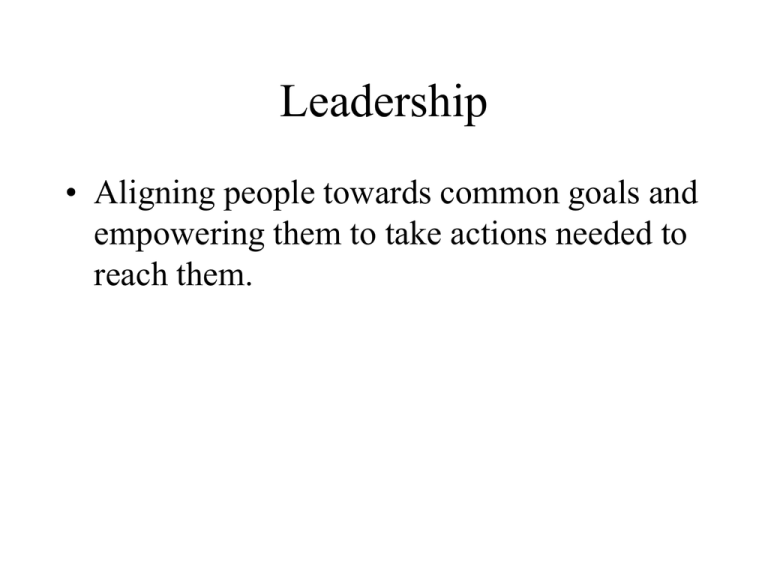
Leadership • Aligning people towards common goals and empowering them to take actions needed to reach them. Historically important studies The Iowa Leadership Studies Important features: • 1st attempt to experimentally determine effect of leadership styles on groups • Experimentally crude • Results showed that different style of leadership can produce different reactions from similar group. The Experiment (R.Lippitt & R.K.White, 1930s) • 10 years old boys were subjected to different leadership styles in hobby classes • Styles of leadership: authoritarian, democratic & Laissez-Faire. • Purpose: examine patterns of aggressive behavior in the boys Findings: • Authoritarian leadership:aggressive or apathetic reaction resulting from frustration. • Laissez-faire leadership: greatest number of aggressive acts. • Democratic leadership: fell in between the two extremes The Ohio State Leadership Study • Leader Behavior Description Questionnaire (LBDQ) was developed and used to analyze leadership in various groups and situations. Findings: • Two dimensions of leadership emerged 1. Consideration (recognition of individual needs or relationships). High scorers were: • • • Open & friendly with subordinates Treat subordinates as equals Helped them solve personal/work problems 2. Initiating Structure (goal/task orientation). High scorers were: – – • • • put pressures to meet deadlines Maintain standards of performance Individuals who achieved ‘high-high’ were able to achieve higher levels of performance & job satisfaction Relevance: First study to emphasize importance of both task & human dimensions in assessing leadership Leadership was studied without being effective/ineffective The Early Michigan Leadership Studies • Prudential life insurance company • Twelve high-low productivity pairs of sections were kept under observation. • Each pair consisted of one high producing section and one low producing section. • Other factors were constant. • 24 supervisors & 419 workers were interviewed. Findings • Leadership behavior was categorized in two dimensions: • Employee-Oriented: emphasizes importance of inter-personal relations. High scorers: – personal interest in subordinate needs – accept individual differences among members • Production-Oriented: concerned with tasks & goals. Employees are means to achieve goals. Lead to lower motivation & productivity Result • Employee-Oriented leaders achieve higher job satisfaction & higher group productivity. • Production-Oriented leaders achieve lower job satisfaction & group productivity. Traditional theories of leadership Trait Theories • Concerned with identifying personality traits of leaders The great person theory • Leaders are born with certain traits that allows them to emerge out of situations and become leaders. • “Intelligence” :the only common trait. Group & Exchange theories • In ‘Group approach’ leadership is viewed in terms of leader’s behavior & how it affects/is affected by groups. • Classic Exchange theory means that there should be a positive exchange between leaders & followers. The Leader-Member Exchange Theory • Leaders treat individual subordinates differently • Develop a dyadic (two-person) relationship • Leader develops a ‘in-group’ & an ‘out-group’ of subordinates & treats tem accordingly • Research shows that ‘In-group’ subordinates: – Report fewer difficulties with leader – Perceive leader to be responsive to their needs – Assume greater responsibility & are high performers • The leaders tend to: • ‘supervise’ those in the ‘out-group’ • Spend more time ‘leading’ those in the ‘Ingroup’. • The basis for choosing groups: – – – – Similar attitudes & personality Higher competence Extraversion Better performance • LMX is reciprocal process • Leaders help subordinate to achieve goals. Contingency theory of leadership • Leaders are viewed as products of time & situation • Leaders have to change their style depending on the situation Fiedler’s Contingency model of Leadership Effectiveness • Relationship between leadership style & favorableness of the situation • Under very favorable/unfavorable situations, taskdirected / authoritarian leader is most effective • For moderately favorable: human oriented / democratic leader is most effective • Situational favorableness is described in terms of three dimensions: • The leader-member relationship (extent to which leader is accepted& respected by subordinates) • The degree of task-structure (task is highly structured & everything is ‘spelled-out’ • The Leader’s position (authority & power attributed to leader’s position) • • • • • Criticism: Narrow focus on one trait of leadership Ambiguity in dimensions’ measurement Contributions: First contingency theory Emphasizes importance of situation & leader’s characteristics for measuring effectiveness Stimulated a great deal of research Path-Goal Leadership theory • Explains the impact of leader behavior on subordinate motivation, satisfaction & performance • Four styles of leadership (House): – – – – Directive Leadership Supportive leadership Participative leadership Achievement oriented leadership • Using one of the styles, leaders provides support & guidance to subordinates to achieve goals • Attempts to influence subordinate perceptions & motivate them. • Situational factors that effect leaders behavior: • Personal characteristics of subordinates • Environmental demands & pressures facing subordinates The Path-Goal Relationship Modern theoretical processes of leadership Charismatic Leadership Theories • Who by the force of their personal abilities are capable for having profound & extraordinary effect on subordinates • Characteristics of charismatic leaders (Robert House): – – – – Self confidence & confidence in subordinates High expectations from subordinates Vision Leading by example Bass included: • Superior debating & persuasive skills • Technical expertise • Fostering of attitudinal, behavioral & emotional changes in followers. Transformational leadership theory • James MacGregor Burns identified two types of political leadership: • Transactional (involves an exchange relationship between leaders & followers) • Transformational (leader’s shifting the values, beliefs & needs of their followers) Transactional leaders: • Contingent rewards • Management by Exception(active/passive) • Laissez-faire • • • • • • Transformational Leaders: Charisma Inspiration Intellectual stimulation Individual consideration Transactional leadership leads to mediocrity in many situations & transformational leadership leads to superior performance (Bass) Characteristics of effective transformational leaders: Identify themselves as change agents • • • • • Courageous Believe in people Value driven Lifelong learners Have the ability to deal with complexity, ambiguity & uncertainty • visionaries Classic Leadership Styles Blake & Mouton’s Managerial grid Hersey & Blanchard’s Situational Approach Two major styles of leaders: • Task style • Relationship style • Maturity level of the followers was incorporated . Criteria for maturity: – Degree of achievement orientation – Willingness to take responsibility – Amount of education/expertise • Effective leaders match up the situation to appropriate style of leadership • Styles of leadership: 1. Telling style (high task; low relationship; effective when followers have low maturity) 2. Selling style (high task; high relationship;followers have low maturity) 3. Participating style (low task; high relationship; high maturity of followers) 4. Delegating style (low task; low relationship; very high maturity in followers) Vroom’s Leadership-Participation model • Relationship between leadership behavior & decision making style. • Leaders must adjust their behavior depending on the situation • Provides a sequential set of rules for ascertaining the types and amount of participation required in decision making in different situations. • • • • • Problem attributes Leader should assess a situation in terms of the problem attributes. Two categories (for 12 attributes): Decision Quality: cost consideration, information availability,nature of problem structure Employee- acceptance: need for commitment, prior approval, conflicts, goal congruence (personal & orgn). Others: subordinate information level, time constraint, geographical distance with subordinates, leaders’ motivation • • • • • • Leadership styles: After identifying the nature of the problem, leader can adopt one of the following styles of leadership: Autocratic I Autocratic II Consultive I Consultive II Group II Assumptions • Leaders can precisely classify problems by following the decisions tree format • Leaders are willing to and can adapt their style as per the situation • Employees accept leader’s classification of the situation & the leadership styles adopted Leadership styles • The way in which leaders influence their subordinates Various styles: • Autocratic • Consultative • Laissez-faire or subordinate-oriented • Democratic • Manipulative • Expert • • • • Likert’s four systems of management System 1 management : ‘exploitiveauthoritative’ style System 2 management: ‘benevolent authoritative’ style System 3 management: ‘consultative’ style Style 4 management: ‘participative’ style What skills do leaders need? • • • • • • Skills needed in the glogal economy: Cultural flexibility Communication skills HRD skills Creativity Self-management of learning • • • • • • • • • • Whetten & Cameron’s list for effective leaders: Verbal communication Managing time & stress Managing individual decisions Recognizing, defining & solving problems Motivating & influencing others Delegating Setting goals & articulating a vision Self-awareness Team building Managing conflict Characteristics of these skills: • The skills are behavioral • Skills are contradictory or paradoxical • Skills are inter-related & overlapping.
